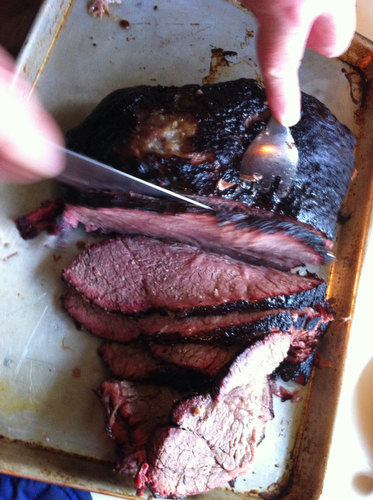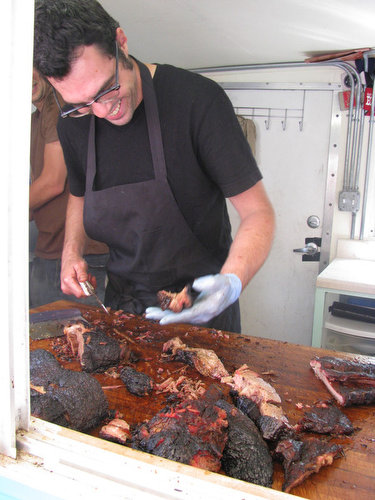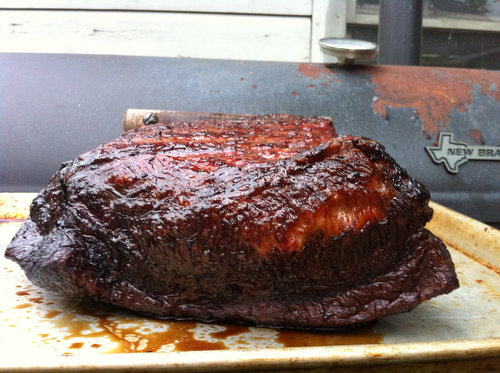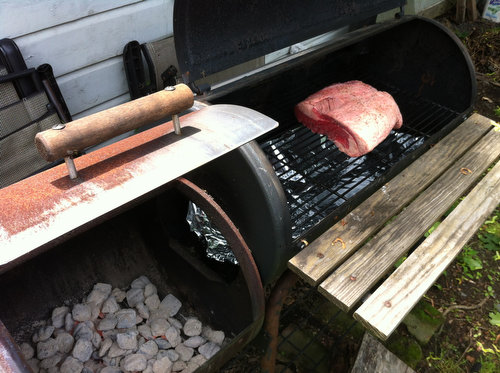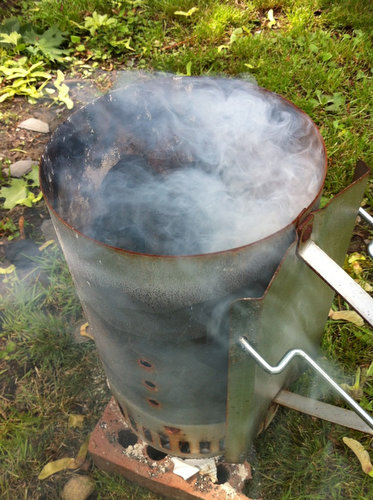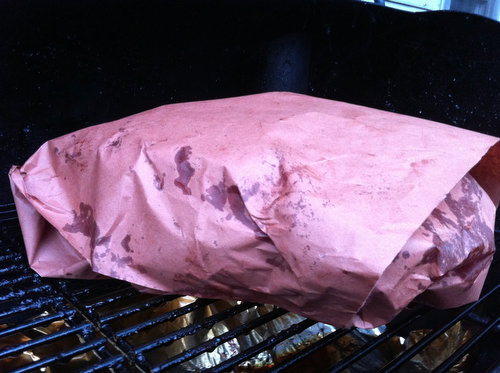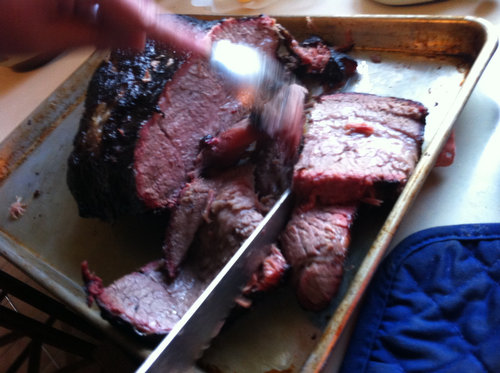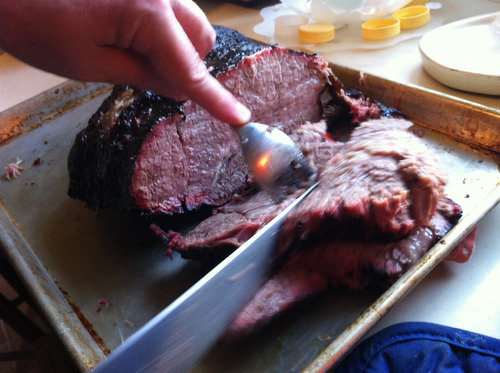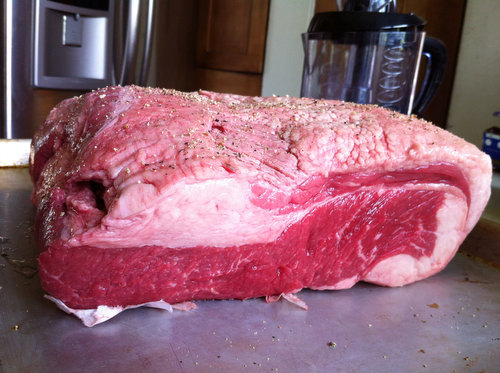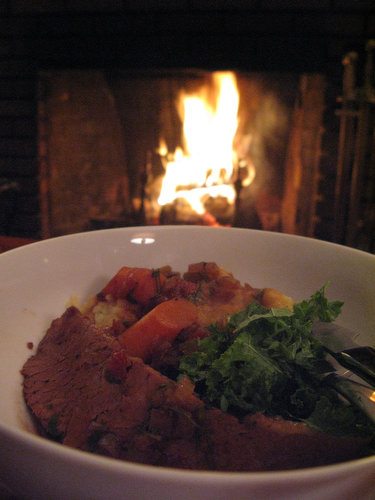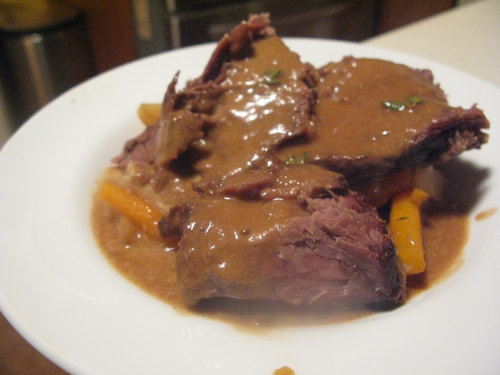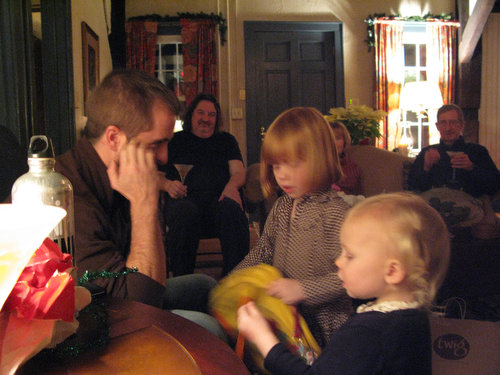SCF fans may remember our trip to Franklin Barbecue back in 2010. Well that little barbecue trailer has become the most popular barbecue restaurant in Austin, which is to say it is some of the most popular barbecue in the country.
Aaron Franklin, the owner (above, and you can see him working the ‘cue in those photos in the link above), grew up on barbecue at Martin’s in Bryan, Texas, and then moved to Austin to join a band. It didn’t go anywhere so he started cooking brisket. He got very good at cooking brisket, and then got a job at John Mueller’s Barbecue on Manor Road in Austin. That went out of business and he bought the smoker, got a trailer and opened a barbecue joint around the corner from Sarah and Wilson’s house. The brisket and the espresso sauce are like barbecue ambrosia.
 How do I know all this? A very excellent new cookbook from Robb Walsh, a former food writer for the Houston Press and Austin Chronicle who has a new book out called Texas Eats. It’s as much a history of Texan food as it is a recipe book, but it is both, with stories from all regions of the great state and tales from its immigrants. I plan to read it like a novel, and I can’t recommend it enough. Head over to his site or Amazon or your local bookstore and buy yourself a copy.
How do I know all this? A very excellent new cookbook from Robb Walsh, a former food writer for the Houston Press and Austin Chronicle who has a new book out called Texas Eats. It’s as much a history of Texan food as it is a recipe book, but it is both, with stories from all regions of the great state and tales from its immigrants. I plan to read it like a novel, and I can’t recommend it enough. Head over to his site or Amazon or your local bookstore and buy yourself a copy.
After paging through and dog-earing half the book for recipes I’d like to make, I zeroed in on three recipes for Memorial Day weekend. The centerpiece of my cooking extravangza: Aaron Franklin’s Butcher Paper Brisket. Now those of you who’ve watched our barbecue exploits over the years (and those of you who have lived through the time when Greg thought he would barbecue for our wedding and all of its 150 guests) know that we’ve tried a lot of barbecue recipes.
Recipes for rubs: Dry Rub for Barbecue | Smokestack Rub | Paul Kirk’s Dry Rub
We especially appreciate the technique shown to us by John Stage of Dinosaur BBQ (who eventually catered our wedding after Greg came to the conclusion that barbecuing for 150 on the day he was to be married was not a wise idea). John likes to smoke his ‘cue for a while, then wrap it in foil so it will still cook low and slow but won’t get a lot more smoke and git too smoky.
It seems to us that’s the point of Aaron Franklin’s recipe, as written by Robb Walsh. He smokes the brisket for 6 hours, then sprays it with some Worchestershire sauce mixed with water, then wraps it in butcher paper. The thing about butcher paper, we think, is that it lets in more smoke than the foil, but also lets the meat breathe a little better. People seem to agree with us. It also seems to protect the crispy edges of the ‘cue a little better than foil does.
Barbecue Sauce Recipes: Franklin’s Espresso BBQ Sauce | Quick BBQ Sauce | Kansas City Barbecue Sauce | Dinosaur’s Mutha Sauce
Whatever the case, the recipe was an enormous hit. My advice, as with all barbecue, is to start really really early in the day. Or, if you can’t, do like we did and cook it the day before you plan to eat it. We lobbed off the last hour and a half of cooking that the recipe called for and instead used that time the next day to put the brisket in the oven at 200 for two hours before mealtime.
This recipe takes a very long time to make: 11 or 12 hours. But that’s what makes good barbecue. Low and slow. Have patience and you will be rewarded.
Great barbecue side dishes: Dinosaur’s Baked Beans | Alton Brown’s Amazing Baked Beans | Danny Meyer’s Grandmother’s Potato Salad Stella’s Potato Salad | Sweet Potato Salad | Tennessee Style Coleslaw
Aaron Franklin’s Butcher Paper Brisket
Aaron Franklin smokes his briskets with post oak or live oak, according to Robb Walsh. He also cooks them to the “unheard-of internal temperature of 201 to 203 F.” We cain’t git oak for smoking around here, so we used a combination of briquettes and hickory. Not exactly the same, I know, but the ‘cue came out mighty good. I’ll give you both recipes here, and should you be able to replicate Aaron’s exactly, by all means, try. Our instructions are in ital.
1 (8-10 pound) first-quality beef brisket, untrimmed
Salt and coarsely ground pepper
1/4 cup Worchestershire sauce
1/4 water
Sprinkle the brisket on both sides with salt and pepper. Combine the Worchestershire sauce and water in a mister.
Prepare a fire for indirect-heat cooking in your smoker (the coals on one side only) with a water pan. Use wood chips, chunks or logs and keep up a good level of smoke. The smoker is ready when the temperature is between 275 and 300.
Put the brisket in the smoker on the cool side of the grate and close the lid. Cook for 6 hours, adding wood as needed to keep the fire burning evenly. At this point, test the brisket with an instant-read thermometer; the internal temperature should read 165.
What we did here was use an off-set smoker: Crumple one broadsheet newspaper page and place it under a chimney starter. Fill the chimney 3/4 full of Kingsford briquettes. Light the paper and wait 1/2 hour until the briquettes are glowing orange with grey ash around them. Set them in the smoker’s box. Place several large hunks of hickory on top.
The coals last between 1 to 1 1/2 hours, so you will need to repeat this process every hour. It takes 30 minutes for the coals to be ready (glowing orange with grey ash around them), and you need to always be ahead. Set your timer, and start the coals each hour. Wait until they are ready, then put them in the box, and place the hickory. Wait. Wait and watch. Watch the smoke coming out of the chimney; watch the temperature. Barbecue is an art, not a science.
Remove the brisket from the smoker. Spray it with some of the Worchestershire solution (there will be a lot leftover), wrap it in butcher paper and return it to the smoker. Let it cook in the paper for 2 hours longer.
Remove the wrapped brisket from the smoker and place it in an empty cooler or a 200 degree oven for 3 or 4 hours. The brisket is done when a toothpick passes effortlessly through the fat or an instant-read thermometer inserted into the center registers at least 185 but preferably as high as 203.
Put it in the oven for 2 hours. Placed the butcher paper-wrapped brisket in a gallon freezer bag and put it in the downstairs fridge. (Our downstairs fridge only has beer and wine, so the hope is that the amazing smoky smell won’t infuse any other foods that might be in there. If you don’t have an extra fridge, you might want to do a double-wrap.) Three hours before dinner, remove the brisket from the fridge. Preheat the oven to 250. Let it sit out for an hour. Then reheat, wrapped in paper, on a sheet pan, for 2 hours, until the internal temperature reaches between 170 and 200.)
To ensure the brisket remains moist, do not trim away the fat cap before serving. Slice only as much brisket as needed and serve immediately. The remainder will keep well wrapped in the refrigerator for up to a week.
To see Sour Cherry Farm recipes click here.

